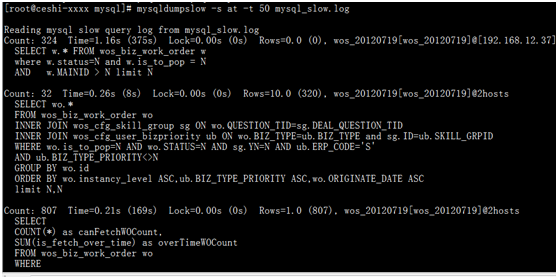MySQL监控
Mysql 监控
mysql大多数问题出现在SQL语句和索引上。
一、慢查询日志分析
show variables like '%slow%' /*查看是否开启了慢查询日志*/
set @@global.slow_query_log = ON /*开启全局慢查询日志,重启mysql失效*/
如果想重启之后有效,需要修改mysql的配置文件my.cnf。在my.cnf的最后添加上:
1 slow_query_log //开启慢查询日志 2 slow_query_log_file=/usr/local/mysql/data/zhoucentos-slow.log //日志的位置 3 long_query_time=0.1 //设定时间为0.1秒,如果查询时间大于0.1的sql语句都会被记录到 日志文件里。
Linux系统使用mysql自带命令mysqldumpslow查看
可通过 mysqldumpslow –help查看帮助信息
-s,是order的排序,主要有 c,t,l,r和ac,at,al,ar,分别是按照query次数,时间,lock的时间和返回的记录数来排序
-a,倒序排列
-t,是top n的意思,即为返回前面多少条的数据
-g,后边可以写一个正则匹配模式,大小写不敏感的
mysqldumpslow -s c -t 20 host-slow.log
mysqldumpslow -s r -t 20 host-slow.log
上述命令分别可以看出访问次数最多的20个sql语句和返回记录集最多的20个sql。
mysqldumpslow -t 10 -s t -g “left join” host-slow.log这个是按照时间返回前10条里面含有左连接的sql语句。
图例中的命令:mysqldumpslow –s at- t 50 host-slow.log 显示出耗时最长的50个SQL语句的执行信息

以Count: 32 Time=0.26s (8s) Lock=0.00s (0s) Rows=10.0 (320), wos_20120719[wos_20120719]@2host 为例:
Count: 32 该SQL总共执行32次
Time = 0.26s (8s) 平均每次执行该SQL耗时0.26秒,总共耗时32(次)*0.26(秒)=8秒。
Lock=0.00s(0s) lock时间0秒
Rows =10.0(320) 每次执行SQL影响数据库表中的10行记录,总共影响 10(行)*32(次)=320行记录
批注:1次查询10条记录所用时间 小于 1次1条查询10次所用时间!
二、连接数
1 show variables like '%connections%' /*查看最大的连接数*/ 2 3 show status like '%connection%' /*查看连接的状态*/
4 Connections :试图连接MySQL服务器的次数; 5 max_connections:整个MySQL允许的最大连接数;
1 show status like '%thread%' 2 其中: 3 Threads_connected 当前打开的连接的数量 4 Threads_cached 线程缓存内的线程的数量 5 Threads_created 创建的线程数 6 Threads_running 激活的(非睡眠状态)线程数
三、缓冲池
1 show variables like '%buffer_pool_size%' 默认是134兆,如果服务器的内存是32G,设置为20G对服务器的性能提升是非常大的! 2 show status like '%buffer%'; 3 其中: 4 Innodb_buffer_pool_reads:缓冲池中没有读到数据,而从磁盘内读取的次数 5 Innodb_buffer_pool_read_requests:来缓冲池中读数据的次数 6 Innodb_buffer_pool_pages_total:缓冲池的总页数(内存是以页为单位) 7 Innodb_buffer_pool_pages_free:缓冲池中处于空闲状态的页数
命中率:innodb_buffer_read_hits=(1-Innodb_buffer_pool_reads/Innodb_buffer_pool_read_requests)*100%

========================================================================================
四、查询缓存(一般默认)
show variables like '%query_cache%'; 查询缓存的本身存在一种算法,如果更新了查询语句就直接去硬盘读取数据,本身也消耗一些性能,所以查询缓存的size很小
show status like '%Qcache%'
查询缓存百分比:Query_cache_hits=(Qcache_hits/(Qcache_hits+Qcache_inserts))*100%
五、线程缓存(连接池,一般默认)
show variables like '%thread%'
show status like 'connections' 试图连接mysql的次数
show status like '%thread%'
线程缓存命中率:Threads_Cache_Hit=(Connections-Threads_created)/Connections*100%
六、表锁和行锁
show status like '%lock%';
存储引擎:早期mysql用的,MyISAM(表锁),现在都用Innodb(行锁)
MyISAM:支持表锁
Innodb:支持行锁



